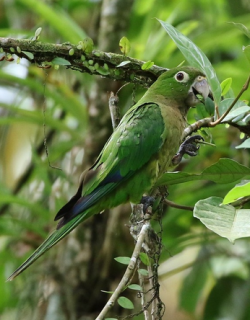Olive-throated Conure |
|
|
Also known as: Olive-throated Parakeet, Jamaican Conure
Photos
View in GalleryDid You Know?
The Olive-throated Conure prefers to fly swiftly in groups of up to 30 birds, in tight formation twisting and turning through the treetops like shoals of feathered fish.Academic Research
Related publications: Eupsittula nanaSpecies Profile
Genus: Eupsittula | Species: nana
Size:
26cm (10.1 in)
Weight:
73-85g (2.5-3 oz)
Subspecies including nominate:
one
Colour Adult:
Both adults-green with a bright green rump; cheeks and ear coverts bright green; throat and breast olive/brown. Bill horn coloured with pale grey at base. Bare eye ring white in colour; eye orange.
Colour Juvenile:
As in adults but with brown eyes.
Call:
Described as noisy and screechy in flight. Also high-pitched notes; sustained harsh twittering sounds with upward inflection. Also piercing chirps.
Listen NowVideo Links:
Video 1 | Video 2More Information:
Content Sources:
CITES
BirdLife International
Cornell Lab of Ornithology/Birds of the World
A Guide to Parrots of the World, Juniper and Parr, 1998
Parrots of the World, Forshaw and Cooper, 1977
Parrots of the World, Forshaw, 2006.
Lexicon of Parrots, Thomas Arndt.
Parrots in Aviculture, Low, 1992.
ML Media Catalogue 204522 Olive-throated Parakeet Eupsittula nana, Proctor, C. Justin, Trelawny, Jamaica, Feb. 11 2015, Cornell Lab of Ornithology.
Photos
View in GalleryDid You Know?
The Olive-throated Conure prefers to fly swiftly in groups of up to 30 birds, in tight formation twisting and turning through the treetops like shoals of feathered fish.Academic Research
Related publications: Eupsittula nanaSpecies Care
Captive Status:
Rare
Longevity:
15+ yrs.
Housing:
Aviary or suspended cage, minimum length 2 or 3m (6.5 or 9.8 ft).
Diet:
Fruit such as: apple, pear, orange, cactus fruits, pomegranate, etc, forming about 30 percent of the diet; vegetables such as: carrot, celery, green peas and beans, corn; green leaves such as: Swiss chard, lettuce, sowthistle, dandelion, chickweed, etc; spray millet; mix small seeds: canary, millet, and smaller amounts of oats, buckwheat, safflower; soaked and sprouted sunflower seed; cooked beans or pulses, and complete kibble.
Enrichment:
Chew items such as bird safe wood (fir, pine, willow or elder) or vegetable tanned leather toys; also enjoys bathing, so provide overhead misters or shallow water bowls. Large flight for groups.
Nest Box Size:
Diagonal nest box 8" x 12" x 10" (20.3cm x 30.5cm x 25.4cm).
Clutch Size:
4 or 5
Incubation Time:
About 25 days.
Fledging Age:
About 8 weeks.
Hatch Weight:
Not recorded.
Peak Weight:
Not recorded.
Weaning Weight:
Not recorded.
Photos
View in GalleryDid You Know?
The Olive-throated Conure prefers to fly swiftly in groups of up to 30 birds, in tight formation twisting and turning through the treetops like shoals of feathered fish.Academic Research
Related publications: Eupsittula nanaSpecies Wild Status
World Population:
10,000-20,000 mature individuals.
IUCN Red List Status:
Near Threatened
CITES Listing:
Appendix II
Threat Summary:
Threatened by exploitation for the pet trade, habitat loss and persecution. Although the population remains small it is still common and widespread on Jamaica and is increasing rapidly in the Dominican Republic.
Range:
Jamaica, West Indies.
Habitat:
Seen in wooded hills, mountain slopes, scrub, cultivation and gardens in humid or semi-arid areas from sea-level to mid-elevation forest.
Wild Diet:
Prefers figs including Erythrina, Bauhinia and Spathodia, and other fruits, also unripe tamarind pods. Will utilize cultivated crops including flowers of Cannabis sativa.
Ecology and Behaviour:
Large groups congregate after breeding or where food is abundant. Will mix with other species. Tree hollows used for nesting.
Clutch and Egg Size:
4 or 5 rounded eggs, 26.5 x 22.0mm (1 x 0.8 in).
Breeding Season:
March-June; nest is in arboreal termitarium or tree cavity.
Related Links:
Photos
View in GalleryDid You Know?
The Olive-throated Conure prefers to fly swiftly in groups of up to 30 birds, in tight formation twisting and turning through the treetops like shoals of feathered fish.Academic Research
Related publications: Eupsittula nanaMembers Only Resources
Please log-in now to find more research, resources and tools.
Not a Member?
Find more great information:
Gain exclusive access to 600+ pages of additional research, seminars and podcasts, specialists to ask your toughest questions, and dozens of other fun resources - when you become a WPT member.
Join Today >>

































